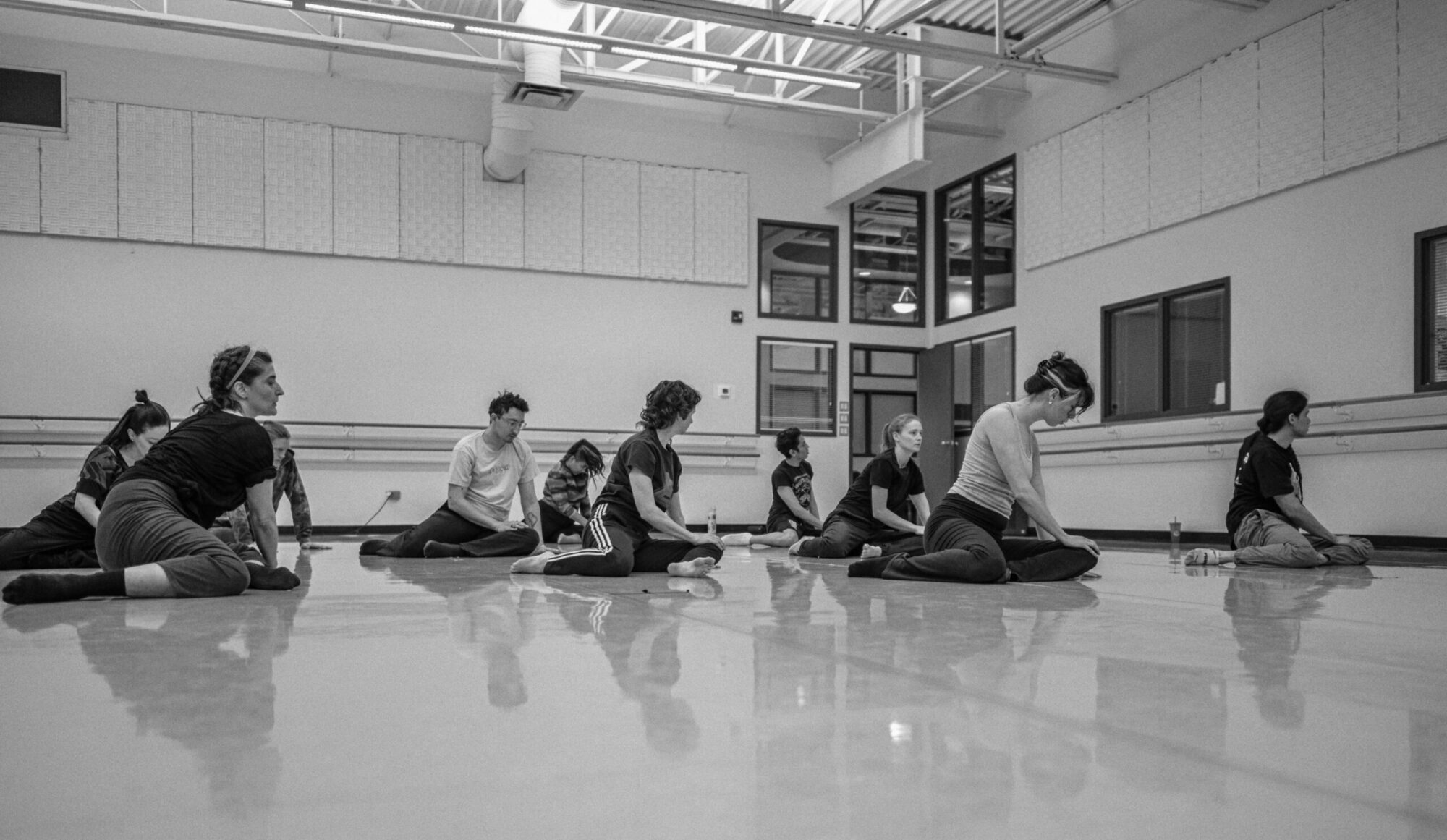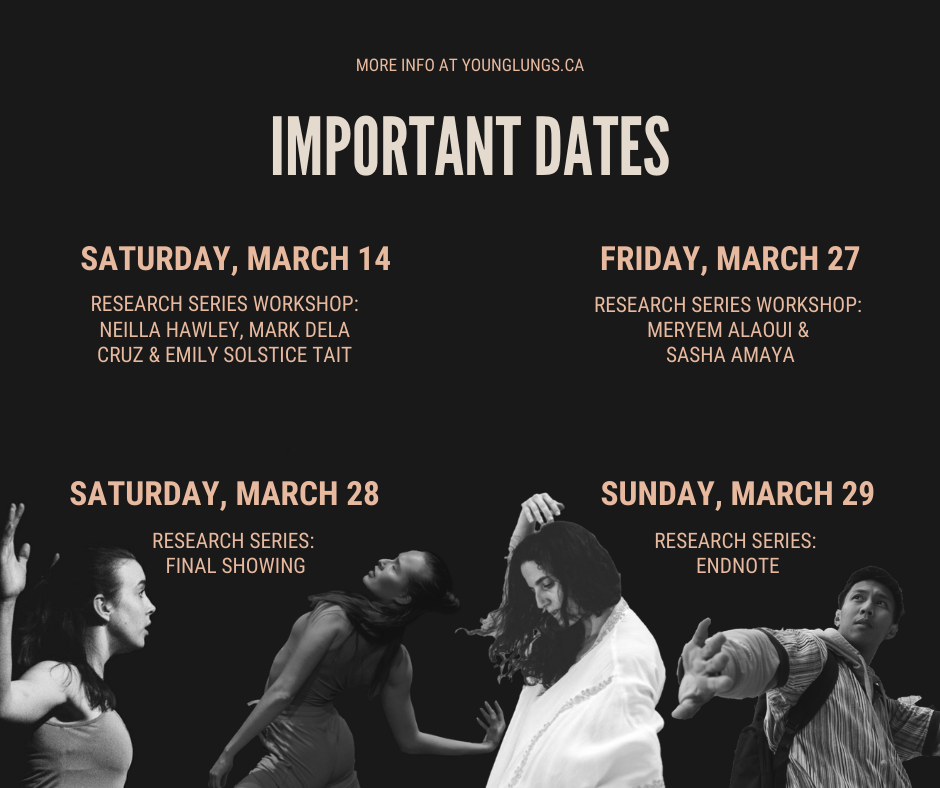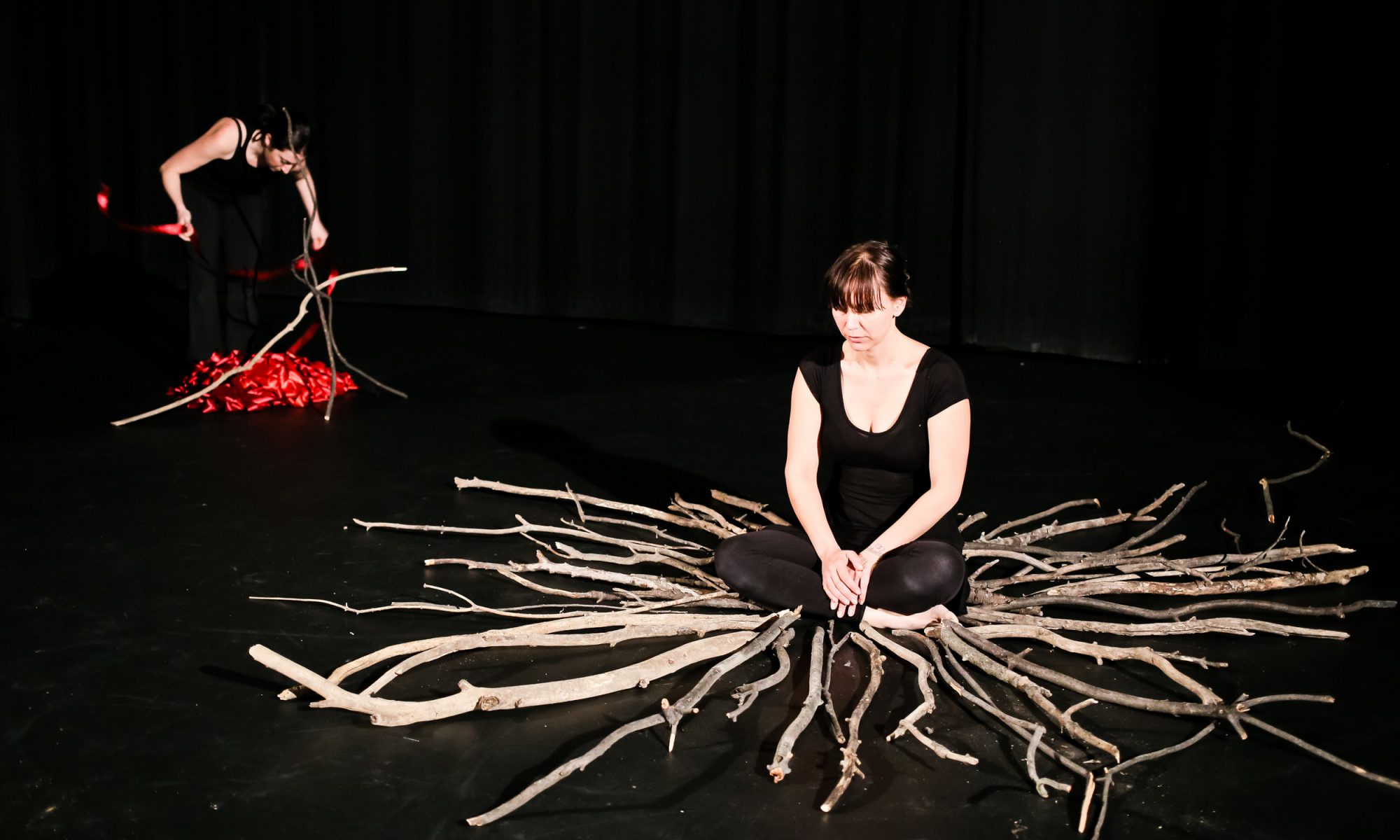by Beth Schellenberg
2018 November – January Research Series
The morning I head to the Young Lungs studio is biting, the cold and sun making my eyes water. I am one of the last to arrive, and after removing a comical number of layers and setting my boots alongside the others, I enter the studio where researchers have already begun warming up. Two dancers in black athletic wear are being coached by a woman wearing lavender wool socks and a pink ponytail holder the same hue as her scarf. Another trio is across the room, squatting, shaking out limbs, humming and groaning. I recognize Alex, a local contemporary dancer, in a brown turtleneck and floral sweatpants, and Davis in black wearing glasses, I don’t recognize the third person, who is wearing royal blue and light grey, and has a head of tousled blond hair hanging around her shoulders. None of them look as sleepy as I feel, despite my early morning consumption of both coffee and green tea.
The last people arrive, introductions are made, and Brittney, the woman in blue and grey, Alex, and Davis begin with an interactive exercise they introduce as “fast sound and gesture”. The three stand in a circle and mimic each others actions, starting with facial expressions that evolve into sound and movement, growing bigger and louder with each passing minute. The result is disconcerting, and their groans, sometimes escalating into howls, are agonized, as though the sound is being pulled from deep within their bodies – with the sound goes their physical strength, leaving behind a quiet crumpled form. This exercise seems to last forever, and for the first of many times that morning I am taken by how willfully exposed these people are. There is often a vulnerability inherent in morning time, a state of being if not unguarded at least less guarded, but there is something about this intentional physical state, barefoot and illuminated by massive east facing windows, that is particularly striking.
After warm up the three set the stage for their improv performance, which involves a bathtub, a makeshift sound booth, and several lightbulbs hanging overhead. Alex and Brittany climb into the tub and face each other, while Davis takes a seat behind the mixer. Alex outstretches her hand to Brittany, who kisses it gently, like a lover or a mother, the gesture unbearably intimate. “I want you to come home” says Alex, plaintively, “I want you to come home” she repeats, while rocking Brittany like a child. Alex speaks of counting stars while waiting at night, and counting flakes of cereal when there are no stars. She ends saying “I am lost without you”, and the three switch places, with Alex doing sound and Davis and Brittany in the bathtub. This sequence verges into more bizarre territory but maintains the theme of loss, and of breakfast cereal. Brittany squats precariously on the edge of the tub, lamenting her compulsive consumption of cornflakes, the awful sensation of her teeth chewing cereal, yelling “it’s fucking disgusting, the cornflakes”. She finishes defeated, clutching her head in her hands and saying “the more I eat the more I hope maybe you’ll come home”. They switch again, and the session ends with Alex and Davis in the tub. Davis plays dentist, informing Alex that if she keeps eating cornflakes she’ll ruin her teeth, grind them down into dust, which he mimes by crushing a white pillow between his hands and the lip of the tub. He grabs the back of her head, shoves one of the hanging lightbulbs in her face and screams “say you’ll stop”, Alex, her neck craned and eyes wide, refuses. Davis says “my partner left me yesterday, that’s why all I have to eat is cornflakes, they always bought the groceries”, and slumps back in the tub. The improv snaps back and forth between hilarity and devastation, and is intimate, perhaps due in part to the domesticity the clawfoot tub elicits, but mostly because of the raw emotion spilling forth. The ways in which the prevalent themes of food, compulsive eating, and the fear of crumbling teeth, a textbook indication of anxiety, interact with each other is fascinating, but ultimately makes sense given how connected food is to home is to love is to loss is to anxiety is to food is to home and so on.
The woman in the pink scarf is Hannah, a dancer and choreographer, and her group is up next. After explaining that her piece is playing with ideas of instinctual movements and animal interactions, her dancers Sasha and Ilse begin. They make slow concentric circles by squatting low to the ground and swinging an extended leg, after several turns starting to move more rapidly, around and around, now faster and nearly frantic, approaching distress with ragged breath. After whirling, trapped in motion, for another few turns they collapse, fatigued. Sasha pulls herself into a seated position beside Ilse, who is lying rigid on the ground, observing her impassively for a moment, before lying down as big spoon, comforting her. In the next sequence they begin standing face to face, bodies nearly touching. Sasha is significantly taller but still they move as a many limbed creature, keeping space while maintaining close proximity, exploring the boundaries of bodies, of bond. After flinging their bodies far from each other as though they are opposing magnets, the piece comes to an end with both dancers curled on the floor. This investigation into interaction is not merely physical, it is also an emotional inquiry, an embodied relation that queries non-conscious impulses of empathetic and possibly abject connection.
We break for a few minutes to shift about on the floor, stretching stiffened limbs, before settling in for Jaz’ performance. In the meantime Jaz has been arranging two vessels about ten feet apart from each other, one a large cut glass punch bowl, the other a hand pinched clay bowl. They have also retrieved half a dozen water glasses and an aquamarine plastic pitcher from the studio kitchen. Jaz says that the piece is about ritual, walks over to the punch bowl, straightens their back, and picks up a glass, taking three careful paces before placing it back on the ground. They do this with the remaining glasses, painstakingly arranging them until a circle, roughly ten feet wide, has been formed. Jaz fills the pitcher, drops of water falling from their hand and catching light, the moment pregnant and over too soon as they take measured steps around the circle with the full pitcher. They fill each glass about two thirds, the sounds of pouring water punctuating silence. When all the glasses have been filled Jaz empties them, in the same measured way, into the clay vessel, which they play like a singing bowl, splashing water onto the ground, before lying prone on the floor. This ritual is mesmerizing, the immersive nature of the performance pointed back to a physical remembering, an inherited motion.
After the performances are done, the spilt water has been mopped up and people rearrange on the floor, we sit in a circle and I am confronted again by the vulnerability of this exercise. Perhaps it is commonplace for those in performance communities to witness such openness, but it strikes me that I am surrounded by people I barely know and they are brave enough to use their bodies to communicate ideas that are still in the process of being formed and articulated. This research series, bringing together people from different disciplines, points to a basic and perhaps incredibly reductionist thought: that everyone is seeking, albeit in different ways, to learn about themselves and each other. This is perhaps why it feels so intimate, so vulnerable. Not simply due to the morning, or the physical abandon, but because it is fragile and special to be able to witness strangers searching.
***
Dancer, choreographer, and filmmaker Yvonne Rainer’s psychotherapist once told her “feelings are facts”, a dictum after which she named her autobiography (Rainer), and one so simple as to be stunning. We are told to exist in a certain way, a way that is often based in someone else’s reality because it is more convenient, for society, for the individual, for both, rather than because it is what we are experiencing. These rules are often enforced based on how society perceives different bodies, and accordingly values, restricts, and/or denigrates them.
***
Sartre, famed father of french thought and misanthrope extraordinaire, is one of many philosophers who privileges control over emotions, and applauds striving to maintain mastery over oneself. In fact he seems to hate moments of vulnerability, speaking at length in Nausea about how repulsive humans are when they eat, and how disgusting he finds other peoples bodies. In a letter to a lover who expressed feeling an overwhelming sadness Sartre wrote “I hate and scorn those who, like you, indulge their brief hours of sadness. What disgusts me is the shameful little comedy rooted in a physical state of torpor” (Boulet 61). Sartre not only condemns this person for recognizing her emotional state, but also deems the physical manifestation of these emotions shameful. His vitriolic refutation of the importance of feeling, both physical and emotional, seems to reflect something of the privilege the patriarchy grants certain kinds of people.
***
I recall at various points in my life having my sadness levelled against me, being made to believe it was my fault rather than a product of how I was being treated. I remember how my body felt when I was sad. Times of pain and grief, fear and stasis can be physical, the body manifesting self-doubt in a stutter, tripping over curbs, allowing a glass tumbler to slip just so from a distracted hand. How to move with intention, let alone grace and fluidity, when the mind is reeling, one half using all of its strength to diminish the other? I spent much of my twenties being alternately weightless, about to slip up and away, and so heavy as to sink into the earth. I think I found my way back into myself by learning to un-believe what I had been told – there is power in unlearning.
During that nearly decade long period of general sadness or angst or depression or what-have-you I was told I needed to fight against and overcome, rather than explore, my feelings and intuitions in order to exist in reality. Whose reality? Certainly not mine, in fact this fight against myself took place in order to maintain relationships with people who were convinced their framework of ideals (or as Helene Cixous succinctly put it, their “conceptual orthopaedics” [10]) was a representation of a grand, overarching truth, when in fact it was a constructed ideology allowing them to act beyond the rules of what they disparaged as restrictive “social norms” while still benefiting from those “norms” and the hierarchy they create. This faux-political, airtight rationalizing allowed them to cause harm without culpability. For the most part these people weren’t intentionally malicious, but they were unwilling to engage with empathy and attempt to unlearn behaviour that served them at the expense of others. The troubling thing about my situation is that it is in no way unique, and that as a white passing, CIS woman who has a supportive family and network of friends it doesn’t begin to speak to the magnitude of repression faced by so many folks with less privilege than I. What is also troubling is that it echoes how our society at large functions.
Why did these people assume that I should live within their conception of the world, particularly when it was one that disenfranchised me? Is the answer simply the patriarchy? I suppose I could chalk it up to a “power” imbalance: the employer was paying my (minimum) wage, which meant I “owed” him and had to take whatever emotional abuse and sexual harassment he chose to inflict, or: the boyfriend said he “loved me more than anything (and more than anyone else ever would)” which somehow negated devastating betrayals, lies, and manipulations, and placed the onus on me to live with his destructive choices rather than on him to be better. Except this doesn’t feel like power to me, it feels like fear, like they were clutching to their conceptual orthopaedics with a death grip, white knuckled, terrified they would be caught out and lose their place in the world, or god forbid have to accept the validity of other people’s perspectives. Can this fear actually be a sign of hope? Can it be attributed to the fact that things are finally changing, albeit slowly, and that different bodies, minds, and ways of being are finally allowed to survive and thrive, that the white supremacist, capitalist patriarchy (™ bell hooks) we are so used to is finally being challenged?
***
Part of the problem: the enlightenment philosophies that inform our “western” conceptions of identity are built on binaries of mind/body, man/woman, human/animal, light/dark and tend to negate or at least ignore emotional and physical realities that exist beyond that of the privileged white male. Donna Haraway identifies such binaries as part of the “informatics of domination” that impede contemporary resistance to injustice (167). Theories of rationality, detachment, and mastery of oneself create a somewhat brutal meritocracy that demands if one has enough will and intellectual acuity they will ascend a mountain and become what they are (263 Nietzsche). Of course if one is born brown, black, female, impoverished, homosexual, etc. then society tells you what you are and how you are supposed to be, and it often isn’t an uber-mensch. Ultimately the doctrines of philosophies from early enlightenment to existentialist lack empathy, creating a very bleak outlook on human relations and difference.
A possible solution, or at least an alternative to the above: “affect theory”, which is defined as the study of “visceral forces beneath, alongside, or generally other than conscious knowing that can serve to drive us toward movement, thought, and ever-changing forms of relation” (Affect Theory Reader). These explorations acknowledge that bodies provide motivation, attachment, and desire, and strives toward a knowing that is not grounded in what we are told is real, but rather in dismantling those beliefs and focusing on what we feel could possibly exist. Anna Gibbs says that affect theory “might also take the form of an ‘anti-history’ or ‘counter-memory’ which attempts to detach the present from history as a constraining and defining identity so that it can be moved beyond and something other can be invented. This is an enterprise which, in charting the limits of the present, unsettles the taken for granted and suggests that things could be otherwise, leaving the future open” (6). This way of thinking provides a vital departure from enlightenment humanism and the various philosophies it informed, and engenders empathy, allowing more ways of knowing, conceptualizing and experiencing the world.
One of my favourite theorists at the moment is José Esteban Muñoz, who envisions ideas of a utopian, queer futurity through transgressive moments of aesthetic, performative culture. For Muñoz it is the moments taking place outside of, or between, the interconnected systems of domination that define contemporary reality and contain hope. In Cruel Optimism Lauren Berlant also focuses on themes of liminality with her theory of “the impasse” (21), which she defines as “a crucial place that lies between the old habituated life and something different, something that radically resensualizes the subject” (27). Her idea of a “refutation of the precious normative construction of domesticity and privacy [that] leads to an embodiment of the impasse” (Berlant 27) runs along the same lines as Muñoz’ assertion that we must reject the present social structure in order to “dream and enact new and better pleasures, other ways of being in the world, and ultimately new worlds” (1).
If we understand Sartre’s conception of freedom as a tortured knowledge of nothingness (Being and Nothingness) and Muñoz’ “ideality” of freedom to be a site of un-materialized, potential utopia which is predicated precisely on not-knowing, a stark contrast emerges, and at the risk of being reductionist I would guess that these differentiating ways of viewing the world, the non-verbal articulation of ideas versus the enlightenment definition of knowledge and thought, rather alter the ways people understand and perceive one another.
***
They way movement can elucidate ideas and feelings is remarkable, and illustrates how the body functions as a site of emotional and intellectual knowledge, containing information vital about ourselves but also information that is vital when trying to enact a social shift towards a softer, kinder world. Jaz’ ritual connects to a tradition of embodied articulation, and a turn back into oneself, and to the intrinsic knowledge we carry that can reveal previously unknown information. Brittney’s improv is an explosive example of release, the pent up everyday coming out as words and signs, as well as the intuitive bonds that can be forged by crossing disciplinary lines. Hannah portrays a physicality concerned with touch, and the manifestation of varying boundaries and connections we draw between each other, and perhaps within ourselves. These forms of research lie between what is consciously known and what runs beneath the surface, and are an identification of mutable, fluid ideas that can’t quite be pinned down, but whose contours can be traced. This kind of ephemeral performance is what Munoz envisions can literally save the world, and although I’m not as strident a utopian as he, there is a hope inherent in people striving to reach new spaces within themselves, with others, and with their bodies. Anna Gibbs perhaps says it best when she says that research can be “an experimental and productive forging of connections to new ends, rather than the analytical disassembling of a machine in order to show how it works, as if this (the analytic disassembling) were sufficient to bring about desirable change” (4).
BIBLIOGRAPHY
Berlant, Lauren Gail. Cruel Optimism. Durham : Duke University Press, 2011. Print.
Gibbs, Anna. “Writing as Method.” Affective Methodologies,
Gregg, Melissa, and Gregory J. Seigworth. The Affect Theory Reader. Duke University Press, 2011.
Haraway, Donna. “A Cyborg Manifesto: Science, Technology, and Socialist Feminism in
the Late Twentieth Century.” Simians, Cyborgs and Women: The Reinvention of
Nature, New York; Routledge, 1991,149-181.
Muñoz, José Esteban. Cruising Utopia: The Then and There of Queer Futurity. NYU Press, 2009.
Nietzsche, Friedrich Wilhelm, and Thomas Common. Thus Spake Zarathustra. Gordon Press, 1974.
Rainer, Yvonne. Feelings Are Facts: a Life. MIT Press, 2013.
Sartre, Jean-Paul. Being and Nothingness. Routledge, 2007
Sartre, Jean-Paul. Nausea. Penguin Books, 2007.













.jpg) BRITTANY THIESSEN
BRITTANY THIESSEN ALEXANDRA ELLIOTT
ALEXANDRA ELLIOTT DAVIS PLETT
DAVIS PLETT
 HANNAH EVEREST
HANNAH EVEREST SASHA WILDE
SASHA WILDE ILSE TORRES OROZCO
ILSE TORRES OROZCO
 JAZ PAPADOPOULOS
JAZ PAPADOPOULOS GRAHAM WIEBE
GRAHAM WIEBE
